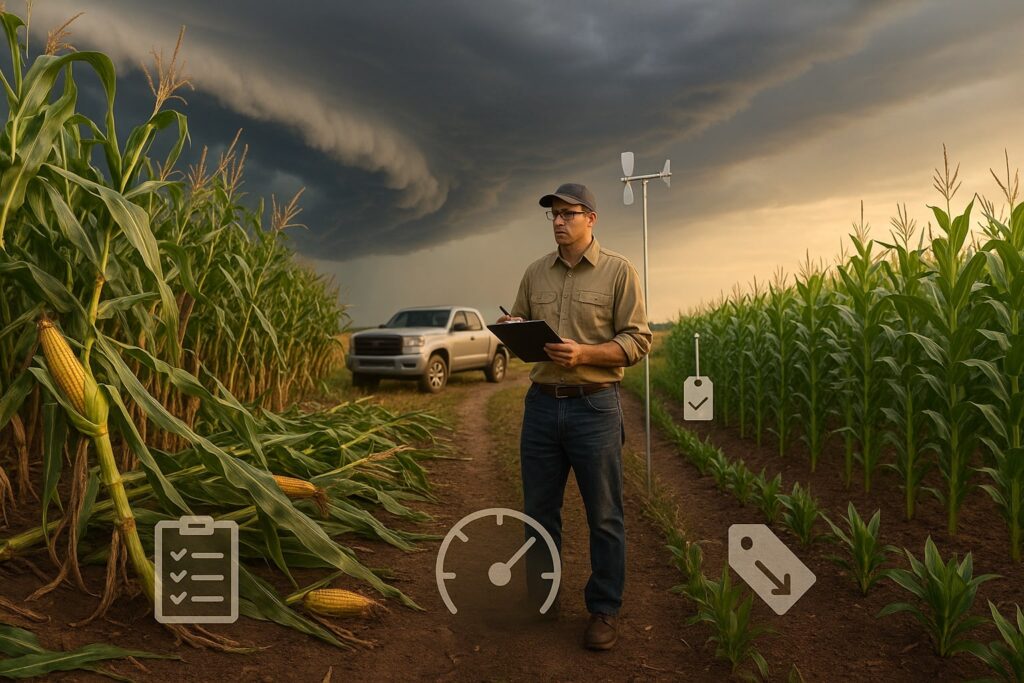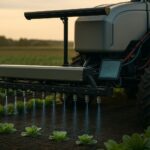Table of Contents
ToggleMaize Under Climate Duress
Corn (maize) is the world’s most widely grown cereal, but it’s increasingly vulnerable to climate extremes. Taller traditional hybrids – often 10-12 feet high – suffer badly in high winds and drought. In the U.S. Corn Belt alone, windstorms flatten millions of corn acres periodically. Meanwhile, hotter, drier conditions driven by climate change threaten yields across continents. This has growers and scientists asking: could short-stature corn be a climate resilience game-changer? And what policy shifts would help scale up this innovation to de-risk maize farming?
Rise of the Short-Stature Hybrid
After decades of work, seed developers are introducing hybrids that stand roughly 20-24 inches shorter than conventional corn. Bayer’s (BAYGn.DE) new lines, for example, grow about one-third shorter than current varieties – roughly 7 feet tall instead of the usual 10+. These stocky plants were field-tested on ~30,000 U.S. Midwest acres in 2024 and will be sold commercially in 2025. Rival Corteva (Pioneer) is close behind with its own short corn, and independent breeders like Stine Seed are also offering hybrids around 7–8 feet tall.
Storm-Proof and Dense-Planting Benefits
By lowering the center of gravity, short corn markedly improves lodging resistance – a big deal as wind events intensify. In Bayer’s 2020 Iowa trial, a catastrophic derecho with 140 mph gusts leveled fields of normal corn, but most short-stature plots “were still standing, completely undamaged.” The hybrids feature thicker stalks and deeper roots that better anchor the plant. Field research at Purdue University confirmed 20-inch shorter plants had similar biomass and yields to taller counterparts, thanks to wider stems and leaves compensating for height. Yields in trials held strong, averaging ~240–300 bushels/acre in Indiana tests – on par with full-size hybrids. In some treatments the short corn even topped 300 bushels/acre, proving it can achieve top-end yields.
Shorter corn also unlocks denser planting and easier management. Purdue researchers saw yield continue rising as populations increased from 34,000 to 50,000 plants/acre in narrow 20-inch rows – densities that would lodge normal corn. Being shorter than a farmer’s head means fields can be accessed throughout the season with standard ground equipment. Farmers can drive sprayers or side-dress fertilizer later in the season without resorting to planes, improving precision and reducing costs and carbon footprint. In fact, the ability to do mid-season “drop” nitrogen applications and targeted spraying is a touted benefit. This could boost nutrient use efficiency and yields while lowering runoff.

Drought Resilience and Water Use
Intriguingly, these hybrids may also handle drought stress better. Breeders report some short-stature lines show reduced leaf rolling and wilting under water stress, indicating improved drought tolerance. Preliminary field observations from Bayer’s VITALA project suggest some short-stature hybrids develop deeper roots, potentially accessing deeper soil moisture, though peer-reviewed confirmation is still limited. Dr. Manuel Oyervides—the researcher behind VITALA—adds that short corn “stays green longer before harvest,” which may reflect improved drought tolerance in Mexican trials. And because the stalks are smaller, the plants may use water more efficiently – one analysis noted shorter corn’s smaller surface area could modestly reduce water use, a plus amid growing drought concerns. All told, early evidence suggests short corn can maintain yields more reliably through heat, dry spells and storms, effectively “de-risking” maize production against climate volatility.
Challenges – and Farmer Appetite
Insurance signal. Several carriers expect short-stature hybrids to translate into fewer wind and green-snap claims over time, but any premium relief will hinge on data. “Short-stature corn has clear potential to reduce wind and greensnap losses due to its lower center of gravity—especially during late-vegetative storms when traditional hybrids are most vulnerable,” said Jaime Arias, President, Dynamic Insurance Solutions, in comments to Industry Examiner.
“To justify a premium discount, insurers would need multi-year plot data showing reduced loss ratios during major wind events. Interim proxies could include comparative lodging rates across side-by-side trials or early private pilot program results showing reduced claims frequency.”
“Short-stature corn has clear potential to reduce wind and greensnap losses…”
— Jaime Arias
From an underwriting standpoint, the proof will be sustained reductions in lodging rates during late-vegetative wind events and, over multiple seasons, lower event-level loss ratios. Any premium discount for adopters is most likely to appear first inside green-snap coverage or wind/hail endorsements, tied to verifiable side-by-side trial results, adjuster reports on standability, and documented claims frequency/severity. If those indicators trend down across pilot cohorts, carriers can flow improvements into base rates rather than one-off credits; if evidence is mixed, pricing changes will remain program-specific and conditional.
Policy Shifts to Scale Up Resilience
Technology alone can’t climate-proof agriculture; supportive policies are needed. A key lever is regulatory approval for biotech traits. While the first wave of short corn (like Mexico’s VITALA) came from conventional breeding, the highest-performing future variants may use gene editing or transgenic traits. In the U.S., biotech short-stature corn is in development for release by ~2027. But in markets like the EU, strict GMO rules could delay access. Encouragingly, Europe is considering new rules to relax regulations on gene-edited crops by 2025, which could open the door for short-stature hybrids adapted to European conditions. Similarly, Mexico’s recent ban on GMO corn imports created uncertainty, but the short hybrid it launched domestically sidestepped this issue by being non-GMO. Aligning biotech policies with climate adaptation goals – for example, fast-tracking approval of drought-/wind-resilient seeds – would help deploy these hybrids globally where they’re needed most.
Governments can also support adoption through climate-smart agriculture programs. For instance, the USDA’s Climate-Smart Commodities initiative or cost-share programs could include incentives for resilient seed varieties. Public crop insurance could formally recognize reduced risk: the U.S. Federal Crop Insurance Program might eventually offer premium discounts for approved climate-resilient hybrids (as it does for other risk-reducing practices). This would accelerate uptake by directly rewarding risk mitigation. Additionally, investment in breeding R&D for diverse short-stature varieties (including open-pollinated types for developing countries) can ensure the benefits reach smallholder farmers, not just large-scale producers. CGIAR institutes, for example, are exploring dwarf maize lines suitable for African and Asian climates, which paired with policies like seed subsidies or distribution programs, could bolster food security under drought conditions.
The Road Ahead
Corn’s climate resilience will come from both innovation and policy. Short-stature hybrids are proving their mettle: easier on inputs, sturdier in storms, and capable of high yields even in tighter spacing. They embody the “more crop per drop” ethos needed for a hotter, hungrier world. But realizing their full potential requires regulatory green lights and supportive farm policies. Agriculture can be “part of the solution” to climate change if such innovations are embraced alongside climate-smart practices. By updating seed regulations, aligning insurance incentives, and investing in resilient crop R&D, policymakers can help de-risk maize at scale. In an era of long droughts and freak storms, a shorter corn stalk – paired with forward-thinking policy – might stand surprisingly tall as a pillar of food security.



